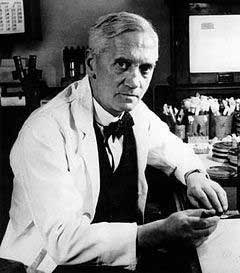Emmanuel Ugokwe
Nigeria Southeast & South South

Sir Alexander Fleming, (1881–1955)
Scottish-born Alexander Fleming spent almost his entire life as a doctor in London, studying the problems of infection and the use of antiseptics. In 1922 he made a remarkable observation. He took a test tube containing water mixed with inoffensive bacteria that turned the water milky. To this he added just one human teardrop. In seconds the milky substance cleared! It was obvious that in human tears there must be a chemical capable of destroying bacteria with astonishing speed. He named it “lysozyme” because it could “lyse,” that is, dissolve, bacteria.
Lysozyme, however, proved disappointing. It was effective against harmless microbes but powerless against those causing disease. The discovery was highly beneficial, however, in that it pointed Fleming to a completely new principle in mankind’s struggle against disease—the destruction of bacteria by using a harmless chemical. It prepared him for a similar incident six years later.
Historic Moment of Discovery
In 1928 in his laboratory, in shallow glass dishes, Fleming was cultivating staphylococci, the bacteria that cause boils. An old friend named Pryce dropped in to see him. Something that was to mean the difference between life and death to multitudes was about to take place. While talking to Pryce, Fleming removed the lids from several of his cultures. Suddenly, he stopped talking. After observing one culture for a moment, he said in his usual unconcerned tone: “That’s funny . . . ” On the culture there was a growth of mold as usual. But all around the mold, the colonies of staphylococci had been dissolved. Instead of forming opaque yellow masses, they looked like drops of dew.
Fleming concluded that something produced by the mold was diffusing the bacteria and dissolving them. Today we know that the something was penicillin, a drug that was to revolutionize medicine. The arrival of the right spore falling out of the air and into the right culture dish may have been the accident of all accidents.
Next, Fleming grew some blue-green mold (similar to that which appears on oranges, stale bread, ripening cheese, and decaying fruit) on the surface of a liquid meat broth. It absorbed nourishment and diffused its antibiotic. After several days it was filtered as a crude juice that Fleming then named penicillin.
In a test tube his mold juice would destroy gonorrhea, meningitis, diphtheria, and pneumonia bacteria. And, most importantly, it was nonpoisonous! Fleming suggested to the medical profession that here might be the ideal antiseptic. His audiences responded with icy indifference. They felt strongly that when bacteria established themselves within the body, they were out of the reach of all chemicals.
Because Fleming and his assistants did not have the know-how to handle the chemistry problems associated with isolating and purifying penicillin, virtually nothing more was done in its development for more than eight years. It seemed penicillin was on the way to being forgotten.
Penicillin Isolated
In 1939, owing mainly to the diseases soldiers were contracting on the battlefield, two scientists educated in medicine and chemistry, Howard Walter Florey and Ernst Boris Chain, joined together in England in an assignment to investigate bacteria antagonism. Their research led them to Fleming’s writings on lysozyme and penicillin. Soon they were working with his mold juice and, after repeated failures, the elusive chemical was finally produced in stable powder form.
There was much excitement when four disease-infected mice were cured. Then, in 1941, the first human was treated successfully. As one scientist reported, “The response to penicillin was considered almost miraculous.” It was demonstrated that penicillin could be diluted 120 million times and still remain effective against bacteria. This was almost unbelievable!
Because of wartime problems, Florey, with his precious mold, transferred from England to Peoria, Illinois, USA. Fleming’s mold was unsuitable for mass producing penicillin. After a very widespread search, Mary Hunt of Peoria, who assisted Dr. Kenneth B. Raper and who was given the title “Mouldy Mary,” found a suitable mold from a rotten cantaloupe. The descendants of its mold have since become the chief source of penicillin. Soon, penicillin was in full production in many countries, and Fleming, Florey, and Chain were awarded the Nobel prize for medicine in 1945.
An Unsolved Mystery
“That’s funny” was the exclamation used by Fleming in 1928 to indicate that what he saw on his culture plate was hard to account for. It does seem incredible that many attempts of numerous scientists, including Fleming himself, have never succeeded in getting the same thing to happen again! “Quite one of the luckiest accidents that has ever occurred in medicine,” commented Lord Florey. Thirty-six years later, Professor Ronald Hare, in an effort to solve the mystery, conducted an elaborate series of experiments and confirmed that what happened in Fleming’s laboratory must have been very exceptional. In 1971 Sir Ernst Boris Chain summarized the then scientific view:
The phenomenon which Fleming observed seems simple and straightforward enough but in actual fact it is not, and few people are aware of and understand its complexity and the fact that it needed the coincidence of several most unusual circumstances to make the observation possible.
Others have expressed the view that Fleming misinterpreted and misunderstood what he saw on his laboratory plate and that it could not have happened in the way Fleming thought it did. If doubts are being expressed as to who actually discovered penicillin, when, and how, the end result remains—a truly remarkable, life-saving drug available to medicine.
EMMANUEL UGOKWE is a Nigerian writer, trained film producer, translator, and journalist. He has been published in many journals, books, and magazines around the world and is the recipient of over 26 awards, including Wordinaction in England, for his drama The Silence. He was also the 2011 Ebedi International Writers Resident in Iseyin Oyo state. Currently, he is a student of journalism and mass communication at Sikkim Manipal University in Ghana.
Highlighted in Frontispiece Fall 2013 – Volume 5, Issue 4

Leave a Reply